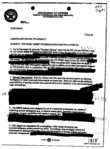Censorship in Nazi Germany
| Part of a series on | ||
| Censorship by country | ||
|---|---|---|
 | ||
| Countries | ||
|
|
||
| See also | ||
Censorship in Nazi Germany was extreme and strictly enforced by the governing Nazi Party. The government attempted to tightly control information available to their citizens. Almost all Modernist art was considered degenerate art by the Nazi regime. Amongst those who were suppressed both during the Nazi book burnings and the attempt to destroy modernist fine art in the "degenerate" art exhibition were:[1]
Philosophers, and sociologists were suppressed by the Nazi Germany:
- Albert Einstein,
- Niels Bohr,
- Edmund Husserl,
- Karl Marx,
- Friedrich Engels,
- Friedrich Nietzsche,
- Sigmund Freud,
- Max Scheler[2]
Politicians suppressed by the Nazi Germany:
To avoid censorship of books they were often given an innocent looking cover, so called Tarnschriften.
See also
References
This article is issued from Wikipedia - version of the 4/12/2016. The text is available under the Creative Commons Attribution/Share Alike but additional terms may apply for the media files.
